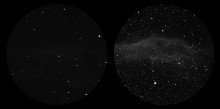I sat down on Saturday afternoon (21st of November) to write my latest astro piece with no idea what I was going to write about. Having endured yet another two weeks of cloud, rain and high winds with no stargazing opportunities, and facing the prospect of the moon (full on Wednesday the 25th) washing out all but the brightest stars over the next couple of weeks, I was at something of a loss. After half an hour of staring at the blank screen I basically gave up without writing a word.
However … Saturday night was set to be clear, and although the moon was well into its waxing gibbous phase, and extremely bright, I thought ‘Well, if I don’t grab this opportunity now, it might be weeks before I get another one!’ So, once the kids were in bed I packed everything into the car and was soon set up; amazingly there were lots of stars on show.
While the scope was cooling* I began with Orion (just clearing Giant Hill in Cerne Abbas). The red supergiant Betelgeuse was a shimmery orange, the three belt stars (Alnitak, Alnilam and Mintaka) a dazzling blue/white. The Orion Nebula (M42) was visible, but lacked contrast and detail because of the glare of the moon. Still nice to see it, though.
Sweeping up to Taurus I picked up the orange/red glow of Aldebaran, and then the bright white stars in the Hyades open cluster. This was very nice and clear, and the stars less shimmery now that the scope had cooled a bit). Sweeping further up, the Pleiades were spectacular, the blue/white stars of the cluster extending beyond the field of view of even my widest eyepiece.
To the left of Aldebaran, and down a bit, is Messier 1, the Crab nebula. Even on a dark night this remains somewhat underwhelming (though at the time when this particular star went supernova – around 1000 years ago – it was very impressive, and records state that it was visible during the day). Amazingly, I found it easily, though it appeared as a faint, nondescript smudge.
Panning left into Auriga, I scanned down through the constellation, first taking in Capella (what appears to be a large, single, yellowish star is actually two binary systems!), and the M38, M36 and M37 open star clusters. Dropping below Auriga I stopped at another open cluster (M35) in Gemini. On a really dark night all four of these clusters are really beautiful, but even when washed out a little by the moon they’re nice.
Sweeping left again, this time to Ursa Major, I wondered if I could see galaxies M81 and M82. Amazingly, even in the light of the moon there they were (faint and fuzzy, but recognisable nonetheless). I never tire of seeing multiple galaxies in the same view, and cannot wait for the return of the Virgo galaxy cluster to the evening sky (now, that really is spectacular). Heartened by being able to pick out these galaxies, I thought I’d have a look for something that’s been on my list for a while now: the California nebula in Perseus. The constellation is very high at the moment, pretty much overhead (which is an awkward direction to observe with a large Dobsonian scope). However, amazingly, there it was, a nebulous band of stars and haziness extending across and beyond the field of view. I’m really looking forward to spending a bit longer on this on a dark night!
Next up I thought I’d have a look for the Horse-head nebula back in Orion (more in hope than expectation). No chance. It was really frustrating, knowing I was looking right at it, but couldn’t actually see it! That’ll have to wait till next time.
By around 11PM some patchy cloud was beginning to build up, so I turned the scope around and had a look at the moon before packing up. I ramped up the magnification to x200, peering into craters, scanning along mountain ranges, and across the flat, smooth basins, and it has to be said, it was really lovely … I wouldn’t normally bother setting up for just the moon, but it was really nice to end a lovely session with it.
So, with frost forming on the scope, and having long since lost contact with my toes, I called it a day. An excellent evening, despite initially low expectations. It served as the perfect reminder to always Carpe Noctem!
* Large Newtonian reflectors need to cool before they perform at their best. All the warm air they contain has to rise out of the tube and be replaced with still, ambient air. The convection currents cause shimmering and distortion …
What’s up?
The moon (full on the 25th of November) will dominate the evenings for the next week or so, after which we should gradually see a return to dark (and hopefully clear) skies. As well as the star clusters I mentioned above, the Crab and California nebulae are well placed at the moment, and you should be able to pick them up in binoculars or a telescope.
From the beginning of December, and early in the morning (from 5.30AM) you may be able to see comet C/2013 US10 (Catalina). Initially low in the south-east, this will appear higher each morning, and should, by mid-January even be visible in the evening sky.
Clear skies!
Kevin Quinn is an amateur astronomer based in Cerne Abbas, he is the proud owner of a ten-inch reflector, a case of eyepieces, and a pair of 20×80 binoculars. He tweets via @CerneAstro, blogs via theastroguy.wordpress.com, and his ebook Demystifying Astronomy – A beginner’s guide to telescopes, eyepieces and accessories for visual astronomy is widely available.
©Kevin Quinn







